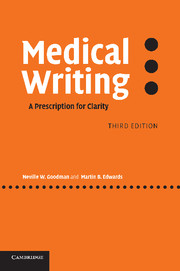Preface to the third edition
Published online by Cambridge University Press: 23 November 2009
Summary
For the second edition, we included more examples and exercises, and a new chapter on that much abused diagram, the graph. For the third, there are new examples and fresh exercises. There are a number of new entries for words that we overlooked or have since and inadvisably become more prevalent. In the 15 years since the first edition, we have not detected any great change in the attitudes of medical writers to the way they write. For this reason, the introductory chapters, which attempt to explain the reasons for poor medical writing, remain much as they were in the previous two editions.
Some attitudes to higher education may make the book even more necessary in the future. Frank Furedi quotes a professor of education who believes essay writing is elitist and that it is, therefore, unfair to ask university students to write them. Educationalists are having an increasing influence in undergraduate and postgraduate medical education in the United Kingdom; there is also the perceived preference of medical schools for ‘privileged’ students, which politicians want to prevent. These influences may make it even more difficult for future doctors to express themselves well on paper.
Frontline journals are receiving more papers now from authors whose first language is not English. We did not mention these EFL (English as a foreign language) authors in earlier editions, and it is not easy to cater for the different grammars that these authors carry mistakenly into their English.
- Type
- Chapter
- Information
- Medical WritingA Prescription for Clarity, pp. xii - xiiiPublisher: Cambridge University PressPrint publication year: 2006



